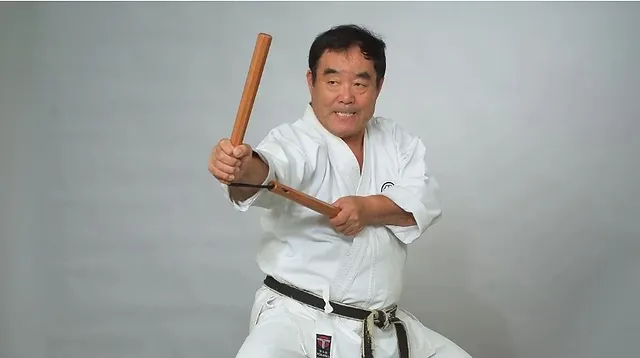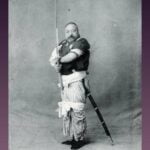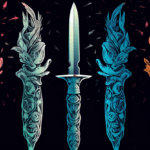Let’s take a peek into the intriguing world of the nunchaku. From its humble beginnings to its legendary status in martial arts, we’ll uncover the history, legality, and cultural significance of this iconic weapon. We’ll explore the question of whether it was used in combat and dig into its association with Japan, China, and beyond. Get ready to learn the real story behind ninjas and nunchakus, and separate fact from fiction as we uncover the true meaning behind its name.
History of the Nunchaku
The nunchaku, those two sticks connected by a chain or rope, have a history as fascinating as their whirling movements. But pinning down their exact origins? That’s a bit of a mystery, much like trying to catch those spinning sticks mid-air!
Some historians believe the nunchaku started out as a humble farming tool used for threshing grain in 17th century Okinawa. Imagine farmers, centuries ago, using a similar tool to separate rice and soybeans from their stalks. It’s not hard to picture how such an everyday object could be adapted for self-defense. After all, when your life depends on it, you learn to use whatever you have at hand. This theory is further supported by the existence of the tabak-toyok, a similar rice-threshing tool used in the Philippines. The resemblance between the two objects raises intriguing questions about possible cultural exchanges and influences across geographical boundaries.
Another theory suggests the nunchaku might have evolved from a horse bit – that metal piece that goes in a horse’s mouth. This idea comes from the resemblance between the two objects and the fact that horses were important in Okinawan culture, where the nunchaku likely originated.
There’s also the “hyoshiki” theory, pointing to a wooden clapper used for making announcements as a possible ancestor. This idea highlights the nunchaku’s potential for creating noise, adding an element of surprise and distraction during a fight.
The earliest written record of something resembling a nunchaku dates back to the Northern Song dynasty in China. The “Wujing Zongyao,” a military encyclopedia compiled in 1044 AD, describes a flail-like weapon used against infantry, suggesting that the nunchaku, or at least a close relative, has existed for centuries.
While its beginnings might be murky, one thing’s for sure: the nunchaku found a home in Okinawan martial arts. Its effectiveness as a weapon, coupled with its portability and concealability, made it a popular choice for self-defense in a time when carrying swords or other obvious weapons was often restricted. During the feudal period in Okinawa, the nunchaku may have served as a potent tool for peasants who were prohibited from owning traditional weapons, allowing them to defend themselves against the ruling samurai class.
But the nunchaku’s claim to fame really took off with a certain martial arts legend – Bruce Lee. When he whipped out those sticks in movies like “Enter the Dragon,” audiences were captivated. Suddenly, the nunchaku weren’t just a weapon; they were an extension of Lee’s charisma and skill, a blur of motion that mesmerized viewers worldwide. Another martial artist, Dan Inosanto, also played a significant role in introducing and popularizing the nunchaku as a practical self-defense weapon.
Thanks to Lee (and other martial artists like Dan Inosanto who also championed the weapon), the nunchaku’s popularity exploded. People wanted to move like Bruce, to have that same command and fluidity. This led to an increase in the study of nunchaku techniques, both for self-defense and for performance.
Today, the nunchaku continues to fascinate and intrigue. Martial arts schools around the globe incorporate it into their training, teaching students coordination, precision, and body awareness. You’ll see it in competitions, demonstrations, and even in movies – a testament to its enduring appeal.
So, while the exact origins of the nunchaku may remain shrouded in the mists of time, its impact is undeniable. It’s a weapon, a training tool, and a cultural icon – a testament to human ingenuity and our enduring fascination with the art of combat.
What is the Origin of Nunchaku?
While we’ve discussed the nunchaku’s history, its exact origin remains a subject of debate, with several theories attempting to explain its emergence.
One prominent theory suggests that the nunchaku was initially a farming tool in 17th century Okinawa, used for threshing grain. This theory posits that the tool was later adapted for self-defense, transforming from a mundane object into a surprisingly effective weapon.
Another theory links the nunchaku’s design to the formidable flail, a weapon used by the Northern Chinese military. Could the nunchaku be a smaller, more refined version of this ancient weapon? The possibility certainly exists.
Adding to the intrigue, there’s a theory connecting the nunchaku to the Philippines. The tabak-toyok, a rice-threshing tool used in the Philippines, bears a striking resemblance to the nunchaku. This similarity has led some to speculate about potential cultural exchanges and influences, suggesting that the nunchaku’s design might have traveled across the seas.
The truth of the nunchaku’s origins may forever remain elusive. However, its shrouded history only adds to the allure of this unique weapon. The nunchaku’s story is a blend of history, speculation, and a touch of mystery, a reminder that even in the world of martial arts, there are still secrets waiting to be uncovered.
Why Are Nunchucks Illegal in the US?
The legality of nunchucks in the United States is a complex issue, with regulations varying significantly from state to state. While the perception of nunchucks as dangerous weapons has driven some states to implement restrictions, the legal landscape is evolving.
For many years, Massachusetts held the distinction of being the only state with an outright ban on nunchucks for personal possession. However, even Massachusetts has begun to reconsider its stance, signaling a potential shift in how these weapons are viewed.
It’s crucial to understand that the absence of a specific “nunchucks are forbidden!” law in a particular state doesn’t necessarily mean you have free rein to wield them. General weapons laws often come into play. For example, bringing nunchucks to school or other restricted areas is likely prohibited in most, if not all, jurisdictions.
The way you use nunchucks also plays a critical role in determining their legality. Owning a pair for practicing martial arts moves at home or in a controlled environment like a dojo is one thing. However, brandishing them in public or using them in a threatening manner is likely to attract unwanted attention from law enforcement and could result in legal consequences.
The debate surrounding nunchucks mirrors broader discussions about self-defense, cultural expression, and the evolving nature of laws. As society grapples with these issues, the legal status of nunchucks will likely continue to be a topic of contention.
If you’re a nunchuck enthusiast or simply curious about these fascinating tools, it’s essential to familiarize yourself with your local laws and stay informed about any changes in regulations.
Were Nunchucks Actually Used to Fight?
The question of whether nunchucks were actually used in combat is a subject of ongoing debate among historians and martial arts experts. While historical records provide limited concrete evidence, we can piece together a probable narrative based on available information and logical deduction.
Given the nunchaku’s likely origins as a farming tool, it’s plausible that it was adapted for self-defense out of necessity. In feudal Okinawa, where carrying traditional weapons was often restricted for commoners, the nunchaku may have served as a discreet yet effective means of protection against bandits or attackers.
However, concrete evidence supporting the widespread use of nunchucks in actual battles is scarce. Some historians speculate that they may have been employed by rebel groups or individuals facing oppression, especially when access to conventional weapons was limited.
It’s important to note that while nunchucks can be deadly in the hands of a skilled practitioner, their effectiveness in real-life combat situations is debatable. The weapon’s intricate movements and the potential for self-injury make it a less practical choice compared to swords, staffs, or other traditional weapons.
While the historical record may not definitively confirm the nunchaku’s role in warfare, its cultural significance in martial arts and its enduring popularity as a symbol of skill and discipline cannot be denied.
Are Nunchucks from Japan or China?
The origin of nunchucks, like many ancient tools and weapons, is shrouded in uncertainty, with multiple theories pointing to different regions of East Asia. While often associated with Japan, particularly due to their prevalence in martial arts films, the truth is more nuanced.
One school of thought suggests that nunchucks originated in China, possibly evolving from agricultural tools used for threshing rice. Proponents of this theory believe that the weapon later made its way to Okinawa, where it was further developed and incorporated into local martial arts styles.
Another theory posits that nunchucks are indigenous to Okinawa, potentially emerging from tools used for breaking horse bits or even as musical instruments in traditional Okinawan music. The close cultural ties between Okinawa and both China and mainland Japan make it challenging to pinpoint the exact origin with certainty.
Adding to the complexity, a less popular theory suggests that nunchucks originated in Southeast Asia, once again highlighting the possibility of cultural exchange and the adaptation of tools for different purposes.
Regardless of their precise origin, nunchucks have undoubtedly been influenced by both Chinese and Japanese cultures. The Chinese term for nunchucks, “shuāngjiégùn,” translates to “two-section stick,” while the Japanese term, “nunchaku,” is thought to derive from an Okinawan word meaning “two parts joined together.”
Today, nunchucks are practiced and celebrated in various martial arts styles worldwide, including Kung Fu, Kobudo, and Karate. Their enduring popularity is a testament to their versatility as a training tool and their undeniable visual appeal. While the mystery of their origin may never be fully solved, nunchucks continue to captivate enthusiasts and spark curiosity about the rich history of martial arts and cultural exchange in East Asia.
Why was Nunchaku Banned?
The banning of nunchucks in various parts of the world, including several states in the US and countries like Canada, stems from concerns about their potential for harm and their perceived association with criminal activity.
In 1974, New York became one of the first states to outlaw nunchucks. The decision came at a time when martial arts films were gaining popularity, and some lawmakers feared that these cinematic depictions of weapons like nunchucks could inspire real-world violence, particularly among young people.
This ban remained in effect for over four decades until a landmark legal challenge in 2018 led to its overturn. James Maloney, a martial arts enthusiast, argued that the ban infringed upon his Second Amendment right to bear arms. The federal judge presiding over the case ultimately sided with Maloney, ruling that nunchucks are not inherently more dangerous than other weapons and that the ban was not justified based on public safety concerns.
The judge’s decision highlighted several key points. Firstly, it acknowledged that despite the decades-long ban, documented cases of nunchuck-related crimes in New York were extremely rare. This lack of evidence suggested that the ban wasn’t effectively addressing a genuine threat.
Secondly, the ruling recognized that nunchucks have legitimate uses beyond criminal activity, particularly in the context of martial arts training and practice. The judge emphasized that the Second Amendment protects the right to possess and use weapons for lawful purposes, and that nunchucks should be afforded the same consideration as other weapons in this regard.
The overturning of the nunchaku ban in New York marked a significant victory for proponents of individual rights and for those who view nunchucks as tools for self-improvement and cultural expression rather than instruments of violence. It also served as a reminder that laws should be grounded in evidence and carefully considered analysis rather than fear or misinformed perceptions.
Are Wooden Nunchucks Illegal?
The legality of wooden nunchucks in the United States is subject to a patchwork of state and local laws, making it essential to understand the specific regulations in your area.
As of 2023, Massachusetts remains the only state with an outright ban on nunchucks for personal possession, including those made of wood. In the other 49 states, the legality of wooden nunchucks is generally determined by a combination of factors, including:
- State Laws: Some states may have specific laws regulating or prohibiting nunchucks, while others may not have any laws explicitly addressing them.
- Local Ordinances: Cities and counties may have their own ordinances that are stricter than state laws, so it’s crucial to check local regulations as well.
- Intended Use: Owning wooden nunchucks for martial arts practice at home or in a designated training facility is generally permissible. However, carrying them concealed in public or brandishing them in a threatening manner is likely to be illegal.
- “Dangerous Weapon” Definitions: Many states have laws prohibiting the possession or use of “dangerous weapons.” Whether nunchucks fall under this definition can be open to interpretation and may depend on the circumstances, the individual’s intent, and the judgment of law enforcement or the courts.
It’s worth noting that there has been a growing trend in recent years towards legalizing or reducing restrictions on nunchucks, particularly in states that previously had bans in place. For example, Arizona, California, and Texas have all overturned their nunchuck bans, citing reasons such as Second Amendment rights, the lack of evidence supporting their inherent dangerousness, and their cultural significance in martial arts.
While the legal landscape surrounding nunchucks continues to evolve, it’s crucial to prioritize safety and responsible ownership. Always research and understand the laws in your specific jurisdiction before acquiring or carrying nunchucks, and use them only for lawful purposes in safe and controlled environments.
Why Do People Call Them Nunchucks?
The word “nunchucks,” now a common term in the English language, has a fascinating etymological journey, reflecting the weapon’s origins in the Ryukyu Islands and its eventual adoption into Western culture.
The original Okinawan term for nunchucks is “nunchaku.” Linguists believe that this word may be connected to an older term from Taiwan, “neng-cak,” which referred to a farm tool. This connection makes sense considering the nunchaku’s likely beginnings as a modified agricultural implement.
The term “nunchaku” entered the English lexicon in the 1960s, coinciding with the rising popularity of martial arts films and the growing fascination with Asian culture in the West. As these fighting styles gained mainstream attention, so did their unique weaponry.
However, the pronunciation of “nunchaku” proved to be a bit of a mouthful for English speakers. The simpler and more phonetically pleasing “nunchuck” emerged as a more accessible alternative and quickly gained traction.
As with many words borrowed from other languages, multiple spellings of “nunchucks” circulated initially, including “nun chuck” and “nunchaku.” However, “nunchuck,” with its streamlined pronunciation and easy memorability, ultimately prevailed as the dominant spelling, becoming the standard term used to refer to this intriguing weapon.
The evolution of the word “nunchucks” highlights the dynamic nature of language and its ability to adapt and transform as cultures interact and exchange ideas. From its humble beginnings as a term for a farming tool in the Ryukyu Islands to its current status as a globally recognized word, “nunchucks” serves as a linguistic testament to the enduring appeal of martial arts and the cultural exchange that has enriched our global vocabulary.
Did Ninjas Actually Use Nunchucks?
The image of a shadowy ninja wielding nunchucks with deadly precision is a staple of martial arts movies and popular culture. However, the historical accuracy of this depiction is questionable. While ninjas, the stealthy warriors of feudal Japan, were undoubtedly skilled in a wide array of weapons and combat techniques, there is little evidence to suggest that nunchucks were part of their standard arsenal.
Nunchucks are generally believed to have originated in Okinawa, an island with a distinct culture and history from mainland Japan. While Okinawa eventually became part of Japan, its martial arts traditions developed independently, influenced by Chinese and Southeast Asian influences.
Ninjas, on the other hand, primarily operated in mainland Japan, where they served as spies, assassins, and guerilla warfare experts. Their weapon choices were dictated by practicality, concealability, and effectiveness in close-quarters combat. Swords, shuriken (throwing stars), kusarigama (sickle and chain), and bows and arrows were among their preferred tools.
The popularity of nunchucks as a “ninja weapon” likely stems from their portrayal in fictional works, particularly in movies and television. The weapon’s visual appeal, its association with martial arts, and its ability to be wielded in a visually striking manner have made it a popular choice for action sequences and fight choreography, even if its historical accuracy is debatable.
So, while nunchucks may not have been a staple of the historical ninja’s arsenal, their presence in popular culture has cemented their image as a weapon of stealth and skill, capturing the imaginations of audiences worldwide.
What Does the Name Nunchaku Mean?
The name “nunchaku” provides insight into the weapon’s structure and its linguistic roots in the Ryukyuan languages, spoken in the Ryukyu Islands, including Okinawa.
In these languages, “nun” translates to “connecting thing” or “joint,” while “chaku” signifies “wooden handles” or “sticks.” Therefore, the term “nunchaku” essentially describes the weapon’s fundamental design: two wooden handles connected by a cord or chain.
However, some language experts propose an alternative theory, suggesting that the name “nunchaku” might have derived from the Min Chinese phrase “nng chat kun.” This phrase literally translates to “two-segment cudgel,” which, like the Ryukyuan interpretation, accurately reflects the nunchaku’s physical appearance.
The exact origin of the name remains a subject of debate among linguists and historians. Regardless of its precise etymology, the term “nunchaku” has become the universally recognized name for this unique weapon, transcending linguistic barriers and cementing its place in the global lexicon of martial arts.
Why Are Nunchucks Illegal in Canada?
Nunchucks are classified as prohibited weapons in Canada, making their possession, sale, or use illegal under the country’s strict gun control laws.
The Criminal Code of Canada, specifically Section 84(1) and 91(2), outlines the legal framework surrounding prohibited weapons, which include:
- Any weapon designed or intended to conceal its identity (e.g., disguised as another object).
- Any weapon capable of firing projectiles by compressed air or gas that is not a firearm.
- Nunchucks and other martial arts weapons deemed dangerous.
The rationale behind Canada’s ban on nunchucks stems from concerns about their potential for causing serious bodily harm. Canadian law enforcement and lawmakers view nunchucks as weapons that pose a significant risk to public safety, particularly if they fall into the wrong hands.
While some individuals may argue that nunchucks have legitimate uses in martial arts training or for self-defense, Canadian law does not recognize these exceptions. The emphasis is on preventing their possession and use entirely to minimize the risk of injury or misuse.
The consequences for violating Canada’s nunchuck ban can be severe, ranging from hefty fines to imprisonment for up to five years. The severity of the penalty often depends on the specific circumstances, such as the intent behind possessing the nunchucks, whether they were used to commit another crime, and the individual’s prior criminal history.
Canada’s strict stance on nunchucks reflects the country’s broader approach to gun control, which prioritizes public safety and aims to prevent gun violence by restricting access to firearms and other weapons deemed dangerous.
Are you eager to discover the intriguing history of the Pupusa? Delve into the captivating origins of this delectable Salvadoran dish and uncover its cultural significance.
Embark on an auditory journey through the history of the Ottoman Empire Podcast and gain insights into the rise and fall of one of the world’s greatest empires. The narrative unfolds with vivid storytelling, expert analysis, and captivating sound effects.
Step inside the history of the Olde Pink House Savannah GA and explore the fascinating tales that have unfolded within its walls. From its humble beginnings as a tavern to its transformation into a renowned restaurant, discover the rich history behind this iconic landmark.
- Mastering Leader in Spanish: The Complete Guide - April 19, 2025
- Uncovering Surprising Parallels: England Size Compared to US States - April 19, 2025
- Old Mexico Map: Border Shifts 1821-1857 - April 19, 2025

















2 thoughts on “Unraveling the Nunchaku: A Journey Through the History of a Legendary Weapon”
Comments are closed.